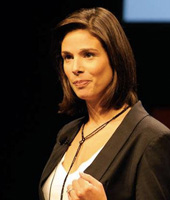Coworking, Freelancing, Carsharing, Crowdfunding, Peer-to-Peer lending… The terms related to the sharing economy have slipped into our lives without us noticing. However, only a few know the real meaning of this new way of life. And it is that in this great drawer of tailor fit, indeed, concepts as varied as the knowledge, the consumption, the production or the finances.
OUTLINE
- Understanding Sharing Economy
- Examples of Sharing Economy
- The key takeaways of the Collaboration Economy
- Lisa Gansky, Rachel Botsman and Roo Rogers on what’s next in the Sharing Economy
Understanding Sharing Economy
Popularized in the 2000s by entrepreneurs Lisa Gansky, Rachel Botsman and Roo Rogers, the expression sharing economy is based on using technology for one’s own benefit: thanks to it, users can organize themselves to achieve a benefit – economic, productive and cognitive wealth.
In simple terms, the sharing economy is the paradigm under which vertical, hierarchical and centralized business models are transformed into horizontal, collaborative and community models.
To this end, the sharing economy seeks to create and develop digital and physical infrastructures that facilitate the exchange between individuals (“Peer-to-Peer”). It is essential to note that the sharing economy is underpinned by a series of principles and values whose central axis is made up of cooperation, local and sustainable economic development, and social responsibility.
Examples of Sharing Economy
The sharing economy, sometimes also called the collaboration economy, is much broader than it seems, because it takes off in all kinds of niches. Within the sharing economy there are several types of relationships that vary according to needs and products:
- Collaborative transport: Share your journey by car. Examples: BlaBla Car or Uber
- Collaborative housing: Sharing a room in your house or the entire apartment when it is not occupied. Examples: Airbnb or HomeAway
- Collaborative funding, which comes in various forms:
- Crowdfunding: allows financing entrepreneurial projects from small contributions from several people. Example: Verkami.
- Crowdlending: loans between individuals to finance projects or facilitate consumption and investment at lower rates than banks. Example: Zank.
- Currency exchange between companies. Example: Kantox.
- Collaborative commerce: Buying and selling second-hand products. Examples: Ebay, Wallapop or Chicfy.
- Collaborative knowledge: Sharing knowledge in an altruistic way. Examples: Wikipedia, make MOOCS in Coursera or exchange and learn languages in HelloTalk.
- Collaborative spaces, in diverse aspects like sharing trunk with Shipeer, sharing lumber room with LetMeSpace or sharing work space and experiences in “coworking”.
- Other types, where we have examples such as Comprea (make the purchase and receive it at home, the shopper earns extra money and the buyer comfort) or Compartoplato (share your food).
The key takeaways of the Collaboration Economy
Today, the possibilities for taking part in the sharing economy are innumerable. There are so many platforms dedicated to this that counting them would be an infinitive task. However, we can identify the main keys that all these platforms have in common:
Some more essential than others, the keys would be the following:
- The efficiency of platform-based models.
- The existence of network effects.
- The reduction of intermediaries.
- The use of technology, which has been fundamental in the rise of the sharing economy.
- Advances in innovation in the provision of services facilitating immediacy and the reduction of transaction costs.
- Positive environmental impact.
- Consumer and user empowerment.
In short, collaboration economy seeks to maximize access to the scarce resources available to the average person, and fosters the economic empowerment of the average person. No matter what stage you are in, if you are contemplating starting a business, you are materializing a new idea, or you are already a successful entrepreneur, we invite you to be a key piece in the transformation that our people yearn for; make it happen!
What’s Next in the Sharing Economy
Many authors have already devoted entire books to this increasingly important concept. Some of the most relevant authors are Lisa Gansky, Rachel Botsman and Roo Rogers. They summarize and show the keys to the collaborative consumption through their essays. We strongly recommend their books and following them in their social media profiles.
Lisa Gansky
Entrepreneur and author
 Lisa Gansky is one of the world’s references in sharing economy and new business models based on sharing. Lisa defends that everything is better when we share, including the world of business. According to Lisa, although the property mentality has blinded us so far, the human being needs to share. This need has emerged thanks to our social life, on platforms such as social networks, and is developing with thousands of types of platforms that allow us to share.
Lisa Gansky is one of the world’s references in sharing economy and new business models based on sharing. Lisa defends that everything is better when we share, including the world of business. According to Lisa, although the property mentality has blinded us so far, the human being needs to share. This need has emerged thanks to our social life, on platforms such as social networks, and is developing with thousands of types of platforms that allow us to share.
Even though business models have been only focusing on three actors (buyer, seller and owner), the new emerging models are beginning to outline a new economic model where the new actor, the consumer, increasingly has more tools, more information and more power in decision making.
Lisa explains the development of these new business models in her book “The Mesh”, with new collaborative business models, where new companies understand and exploit new technologies, new uses of the internet and social networks, that way creating new forms of acting for consumers.
This book, published in 2010 was a revolution, and 9 years later is still a reference for new disruptive business models.
You can follow Lisa Gansky in her LinkedIn and Twitter
Rachel Botsman
Collaborative Economy Professor at the University of Oxford and author
 The Sharing Economy concept was popularized in a book published in 2010 and whose title is sufficiently explicit, “What’s Mine is Yours: The Rise of Collaborative Consumption”. Written by Rachel Botsman and Roo Rogers.
The Sharing Economy concept was popularized in a book published in 2010 and whose title is sufficiently explicit, “What’s Mine is Yours: The Rise of Collaborative Consumption”. Written by Rachel Botsman and Roo Rogers.
The essay started with the irrational consumerist tendency that depletes our planet; and it did so with a devastating example:
“A child born in a middle-class American family will consume in his first eight years of life two and a half million liters of water, the wood of a thousand trees, 21,000 tons of oil, 220,000 kilos of steel and 800,000 watts of electrical energy (…). If everyone lived like an average American child does, we would need five planets to sustain them throughout their lives.”
This data can be read as a call for necessary change. And that is how Rachel Botsman, who has made the expansion of the collaborative economy her great life project, has understood it.
Botsman’s thinking, analyses and readings of these new economic models, necessarily linked to technology and the Internet, have led her to become a prestigious lecturer and advisor to numerous companies and institutions. Changing a model is not easy, but Botsman is confident that we will be able to do it:
“I think we are at the beginning of a collaborative revolution that will be as important as the industrial revolution,” she says.
You can follow Rachel Botsman through her website, Twitter and we strongly recommend watch his TED talks
Roo Rogers
Entrepreneur, business designer and author
 Roo Rogers, co-author with Rachel Botsman of ‘What’s mine is yours’, the flagship book of a trend already known as ‘collaborative consumption’, is inspired by an elementary principle: “Individuals will cooperate to act for the common good”.
Roo Rogers, co-author with Rachel Botsman of ‘What’s mine is yours’, the flagship book of a trend already known as ‘collaborative consumption’, is inspired by an elementary principle: “Individuals will cooperate to act for the common good”.
Rogers goes back to the studies of psychologist Michael Tomasello, author of ‘Why We Cooperate’, who has been able to find ’empathetic and collaborative responses’ in children from the age of two. Against the cherished belief in possessive instinct, Tomasello asserts that children are “sociable and cooperative by nature” and that it is the “cultural norms” they learn from the age of three that end up making them selfish.
Roo Rogers, therefore, argues that Western societies, by mere evolution, have entered a phase of transition from the culture of ‘me’ to the culture of ‘we’. Furthermore, he predicts that the ‘collaborative’ lifestyle, so far associated with the ‘alternative’, will become increasingly visible and more common.
Sources:
https://www.forbes.com/pictures/eeji45emgkh/relayrides/#5837f6c514be
https://www.investopedia.com/terms/s/sharing-economy.asp
https://www.cobizmag.com/articles/pioneers-of-the-shared-economy
https://medium.com/@crowdholding/6-benefits-of-a-sharing-economy-71f4c1dbd42d
https://rachelbotsman.com/about-rachel-botsman/
https://www.fastcompany.com/1776320/roo-rogers-whats-next-sharing-economy

